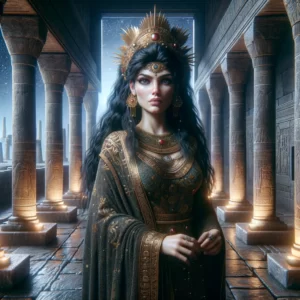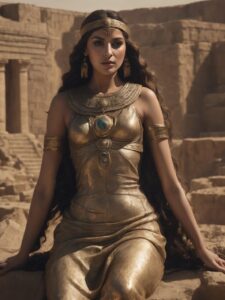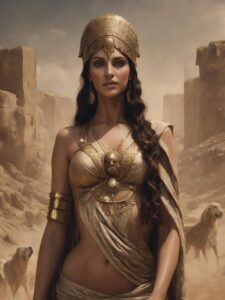Table of Contents
Pronunciation of Inanna: Ee-na-na
Origin: Sumerian
Role: Goddess of sex, war, fertility and sensuality
Parents: Enki or Nanna and Ningal
Husband: Dumuzi
Symbols: Eight-pointed star, lion
Ancient Mesopotamian cultures, particularly the Sumerians, traced Inanna’s origins. They worshiped her as a significant and versatile goddess. Inanna’s earliest references, found in Sumerian texts from the early third millennium BCE, depict her multifaceted nature. As cultural influences spread, her mythology integrated into the broader Mesopotamian pantheon. Consequently, she became identified with the Akkadian goddess Ishtar. Inanna’s myths, revolving around themes of love, fertility, power, and the underworld, showcase her enduring and diverse character.
Family

In Mesopotamian mythology, Inanna is part of a complex pantheon of deities, and her divine family includes several prominent figures. Key members of Inanna’s family:
Anu: Anu is the god of the heavens and the father of Inanna. He holds a high position in the Mesopotamian pantheon, and Inanna’s divine lineage connects her to the highest realms of power.
Nammu/Ki: Considered Inanna’s grandmother and the primordial goddess of the sea and mother of Anu, Nammu, also known as Ki, embodies the creative and life-giving forces in the cosmos.
Enlil: Another crucial deity in the pantheon, Enlil, often regarded as Inanna’s uncle, holds significance. Associated with the air, wind, and storms, he plays a crucial role in various myths and epics.
Ereshkigal: Ereshkigal is Inanna’s sister and the goddess of the underworld. Their relationship is explored in the famous myth of Inanna’s Descent to the Underworld, where Inanna descends to the realm of Ereshkigal.
Dumuzi (Tammuz): Dumuzi, also known as Tammuz, is Inanna’s husband. The myth of Inanna and Dumuzi revolves around their sacred marriage and the cyclical nature of life, death, and rebirth.
Appearance
In various forms of Mesopotamian art, Inanna embodies distinct features and symbols. She typically wears a horned headdress, symbolizing her divine status. Depictions may show her connection to power and courage through association with lions. Symbols of stars, particularly the morning and evening star (Venus), signify her link to Venus. Some representations feature a winged disc, symbolizing divine protection and transcendence. Inanna’s attire often includes a beaded necklace and girdle, possibly representing fertility and sensuality. Holding a scepter and rod in depictions emphasizes her authority and dominion.
Special abilities and personality
Inanna is a complex deity with diverse aspects to her personality and abilities, as depicted in Mesopotamian mythology. Some key attributes:
Power and Authority: Inanna is a powerful and authoritative goddess, associated with love, fertility, and war. She holds a prominent position among the gods and is often invoked for protection and assistance.
Sensual and Fertile Aspects: Inanna embodies sensuality and fertility, and her worship often involved rituals to promote fertility in the land and among people. She is sometimes associated with sacred marriage rites.
Dual Nature: Inanna’s mythology highlights her dual nature, incorporating both feminine and masculine traits. This duality is expressed in her various roles, from a nurturing and fertile goddess to a fierce warrior.
Underworld Journey: One of the most famous myths associated with Inanna is her descent into the underworld. This story emphasizes her courage and willingness to confront challenges. However, it also underscores the cyclical nature of life, death, and rebirth.
Wisdom and Knowledge: Inanna is also associated with wisdom and knowledge. She possesses the “me,” divine decrees or powers that encompass various aspects of civilization, including art, music, and law.
Trickster Qualities: In some myths, Inanna displays trickster qualities, using her wit and cleverness to achieve her goals. This adds a dynamic and unpredictable element to her character.
Stories and Myths

Inanna’s poems, like the Descent of Inanna, manifest her qualities in the rituals and ceremonies dedicated to her. People celebrated the sacred marriage of Inanna and Dumuzi at the autumn equinox to ensure fertility in the lands. During this ceremony, the king and priestess, either symbolically or possibly through actual intercourse, would reenact the sexual union of the god and goddess.
Inanna and the Huluppu-Tree
The story of Inanna and the Huluppu-Tree comes from Sumerian mythology and is preserved in fragments on a cuneiform tablet dating back to the Old Babylonian period (circa 1900-1600 BCE). Summarized version of the myth:
Once upon a time, in the city of Uruk, Inanna planted a Huluppu-Tree in her garden. The tree grew rapidly, but a serpent built its nest at the base, a bird made a home in its branches, and the goddess Lilith built a dwelling in its trunk. Inanna, troubled by the disturbances caused by these creatures, sought the help of her brother, the god of wisdom, Enki.
Enki advised Inanna to seek the assistance of Gilgamesh, the legendary hero-king of Uruk. Gilgamesh successfully drove away the serpent, the bird, and Lilith, clearing the way for Inanna to care for her tree. In gratitude, Inanna promised to use the wood from the Huluppu-Tree to fashion a throne and a bed for herself.
Years passed, and the tree matured. Inanna returned to harvest the wood as promised. She took the wood to the city of Uruk, where it was crafted into a throne and a bed. Inanna placed the throne in her temple in Uruk and the bed in her own shrine. The Huluppu-Tree, once a source of disturbance, now served as a symbol of Inanna’s power and authority.
This myth is often cited for its symbolic significance, representing the taming of chaos and the establishment of order. The Huluppu-Tree’s transformation into a throne and bed also underscores Inanna’s role as a powerful goddess associated with love, fertility, and sovereignty.
Divine Decree in the Abzu
One significant myth involving Inanna and Enki is the “Huluppu-Tree” story, but there’s another notable encounter between them known as the “Me in the E-abzu” or the “Divine Decree in the Abzu.” Summarized version:
Inanna, desiring to acquire the sacred and divine powers known as the “me,” decides to visit the Abzu, the freshwater abyss, where Enki resides. The me encompass various aspects of civilization, including arts, crafts, wisdom, and more. As she dresses herself in her finest attire and embarks on a journey to the Abzu, Inanna undergoes a symbolic act of humility and respect for the god at each gate she passes through on her way to Enki’s dwelling.
Upon reaching Enki’s abode, Inanna requests the me. Enki, known for his wisdom, consents but has a clever plan. He decides to give Inanna the me but in a celebratory and joyous manner. He intoxicates himself with beer and, in his inebriated state, hands over the me to Inanna one by one.
As Enki transfers the divine powers to Inanna, she joyously receives them and departs. However, Enki soon sobers up and realizes what he has done. Distressed, he sends various creatures to retrieve the me, but Inanna manages to escape with the divine powers.
This myth reflects themes of wisdom, cunning, and the transfer of divine authority. It also emphasizes the importance of ritual and ceremony, as Inanna respectfully approaches each gate on her way to Enki’s abode. The story underscores the dynamic relationship between Inanna, representing the forces of life and fertility, and Enki, the god of wisdom and fresh water.
Inanna’s Descent to the Underworld

Inanna, the goddess of love, fertility, and war, decides to visit the underworld ruled by her sister, Ereshkigal. Before her descent, Inanna instructs her faithful servant, Ninshubur, to seek help if she does not return within three days.
As Inanna journeys through the seven gates of the underworld, she must remove one of her divine symbols at each gate, leaving herself vulnerable and exposed. Upon reaching the throne room of Ereshkigal, she faces judgment and condemnation to death. Inanna transforms into a corpse, hanging on a hook in the underworld.
Meanwhile, Ninshubur follows Inanna’s instructions and seeks the help of Enlil, Nanna, and Enki, three powerful deities. Enki, the god of wisdom, creates two creatures from the dirt under his fingernails, imbuing them with the breath of life. These creatures, known as gala-tura and kur-jara, are sent to rescue Inanna.
The gala-tura and kur-jara approach Ereshkigal, sympathize with her pain, and offer to share Inanna’s fate. Ereshkigal is moved by their empathy and grants them a boon. They request Inanna’s release, and Ereshkigal agrees, allowing Inanna to return to the world of the living.
However, the laws of the underworld demand a replacement. Inanna cannot leave without offering someone in her place. When she returns to the upper world, she finds her husband Dumuzi (Tammuz) sitting on his throne, adorned in splendor and not mourning her. Inanna’s rage leads her to choose Dumuzi as her replacement.
Dumuzi’s sister, Geshtinanna, offers to take his place for half the year, allowing Dumuzi to spend the other half in the underworld. This arrangement symbolizes the cycle of the seasons, with Dumuzi’s death in the underworld corresponding to the barren winter months and his return representing the arrival of spring and fertility.
The myth of Inanna and Dumuzi is a powerful narrative that delves into the themes of sacrifice, renewal, and the interconnectedness of life and death in the ancient Mesopotamian worldview.
FAQ
What are Inanna's main attributes?
Inanna is known for her multifaceted nature, embodying qualities of love, fertility, power, and courage. Her mythology also explores themes of life, death, and rebirth.
How was Inanna worshiped in ancient Mesopotamia?
Inanna was worshiped through various rituals, ceremonies, and festivals. The sacred marriage ceremony, symbolizing the union of Inanna and Dumuzi, was a significant part of her worship.
What is the significance of Inanna's Descent to the Underworld?
Inanna's Descent to the Underworld is a myth symbolizing the cyclical nature of life, death, and rebirth. It explores themes of sacrifice, renewal, and the interconnectedness of the cosmos.
Who are Inanna's family members?
Inanna's family includes Anu (father), Nammu/Ki (grandmother), Enlil (uncle), Ereshkigal (sister), Dumuzi (husband), and other divine figures within the Mesopotamian pantheon.
What symbols are associated with Inanna?
Inanna is often depicted with symbols such as a horned headdress, lion imagery, stars (representing Venus), a winged disc, a beaded necklace, and a scepter, each carrying symbolic significance.
How did Inanna influence Mesopotamian culture?
Inanna played a central role in religious and cultural practices, influencing art, literature, and rituals. Her mythology reflected societal values and beliefs of the time.
What are some famous myths involving Inanna?
In addition to her Descent to the Underworld, Inanna is associated with the Huluppu-Tree myth and the myth involving the acquisition of the "me" from Enki's Abzu.
